1993 CHEVROLET CAMARO tow
[x] Cancel search: towPage 263 of 358
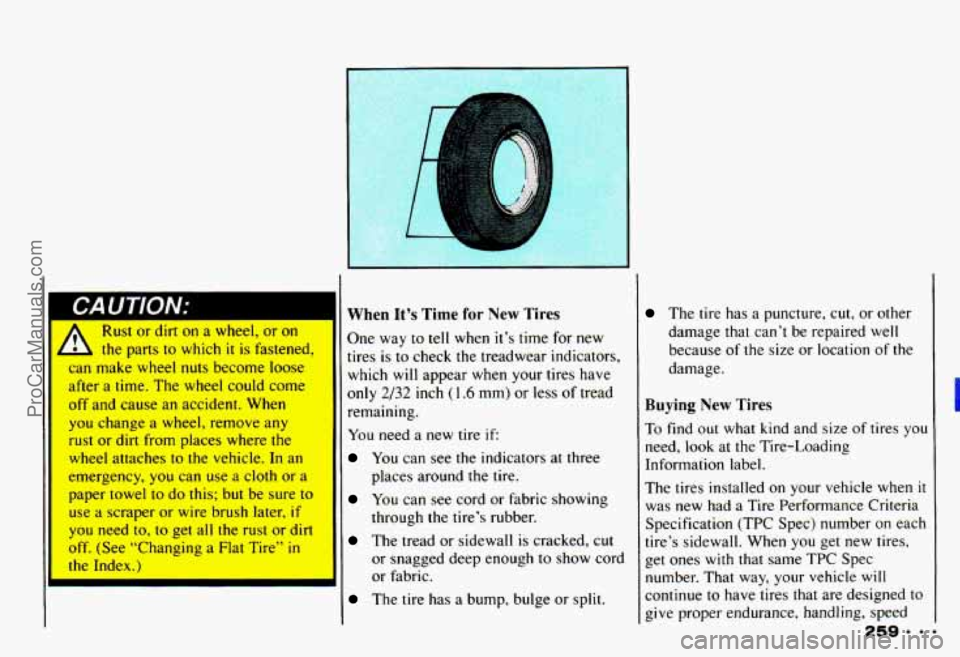
Rust or dirt on a wheel, or on
- the parts to which it is fastened,
can make wheel
nuts become loose
after a time. The wheel could come
off and cause an accident. When
you change a wheel, remove any
rust
or dirt from places where the
wheel attaches
to the vehicle. In an
emergency,
you can use a cloth or a
paper towel to do this; but be sure to
use a scraper
or wire brush later, if
you need to, to get all the rust or dirt
off. (See “Changing
a Flat Tire” in
When It’s Time for New Tires
One way to tell when it’s time for new
tires
is to check the treadwear indicators,
which will appear when your tires have
only
2/32 inch (1.6 mm) or less of tread
remaining.
You need a new tire if:
You can see the indicators at three
places around the tire.
through the tire’s rubber.
or snagged deep enough to show cord
or fabric.
You can see cord or fabric showing
The tread or sidewall is cracked, cut
The tire has a bump, bulge or split.
The tire has a puncture, cut, or other
damage that can’t be repaired well
because
of the size or location of the
damage.
Buying New Tires
To find out what kind and size of tires you
need, look at the Tire-Loading
Information label.
The tires installed on your vehicle when
it
was new had a Tire Performance Criteria
Specification (TPC Spec) number
on each
tire’s sidewall. When you get new tires,
get ones
with that same TPC Spec
number. That way, your vehicle
will
continue to have tires that are designed to
give proper endurance, handling, speed
ProCarManuals.com
Page 271 of 358
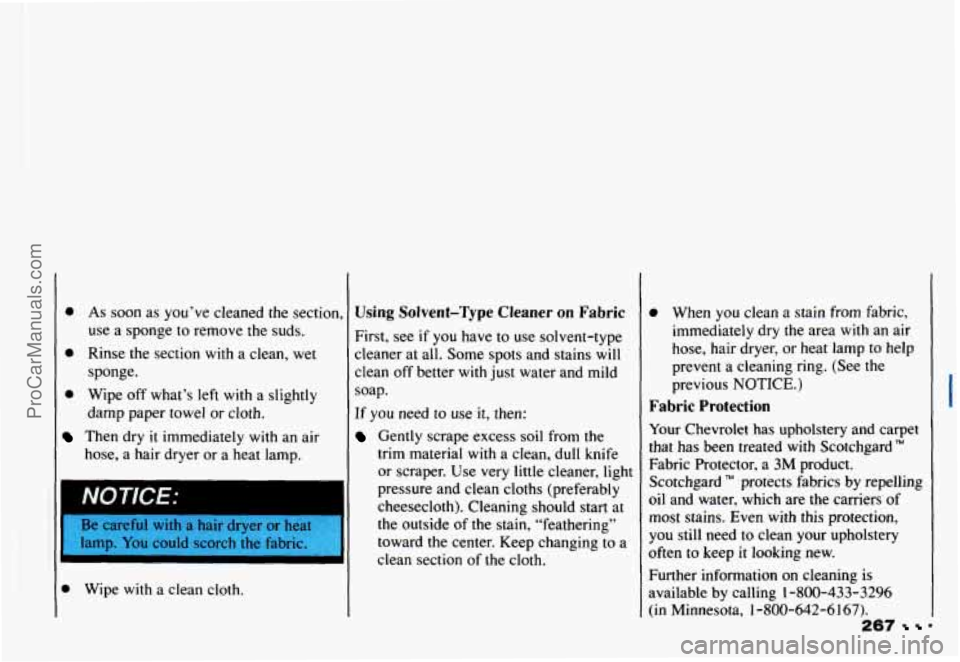
I1
0 As soon as you’ve cleaned the section,
use a sponge to remove the suds.
0 Rinse the section with a clean, wet
sponge.
0 Wipe off what’s left with a slightly
damp paper towel
or cloth.
Then dry it immediately with an air
hose, a hair dryer
or a heat lamp.
~ NOTICE:
Be careful with a hair dryer or heat
lamp.
You could scorch the fabric.
B Wipe with a clean cloth.
Using Solvent-Type Cleaner on Fabric
First, see if you have to use solvent-type
cleaner at all. Some spots and stains will
clean off better with just water and mild
soap.
If you need to use it,
then:
Gently scrape excess soil from the
trim material with a clean, dull knife
or scraper. Use very little cleaner, light
pressure and clean cloths (preferably
cheesecloth). Cleaning should start at
the outside of the stain, “feathering”
toward the center. Keep changing to a
clean section of
the cloth.
0 When you clean a stain from fabric,
immediately dry the area
with an air
hose, hair dryer,
or heat lamp to help
prevent a cleaning ring. (See the
previous NOTICE.)
Fabric Protection
Your Chevrolet has upholstery and carpet
that has been treated with Scotchgard”
Fabric Protector, a
3M product.
Scotchgard
” protects fabrics by repelling
oil and water, which are the carriers
of
most stains. Even with this protection,
you still need to clean your upholstery
often to keep
it looking new.
Further information on cleaning is
available by calling 1-800-433-3296
(in Minnesota, 1-800-642-6 167).
267 =
ProCarManuals.com
Page 275 of 358
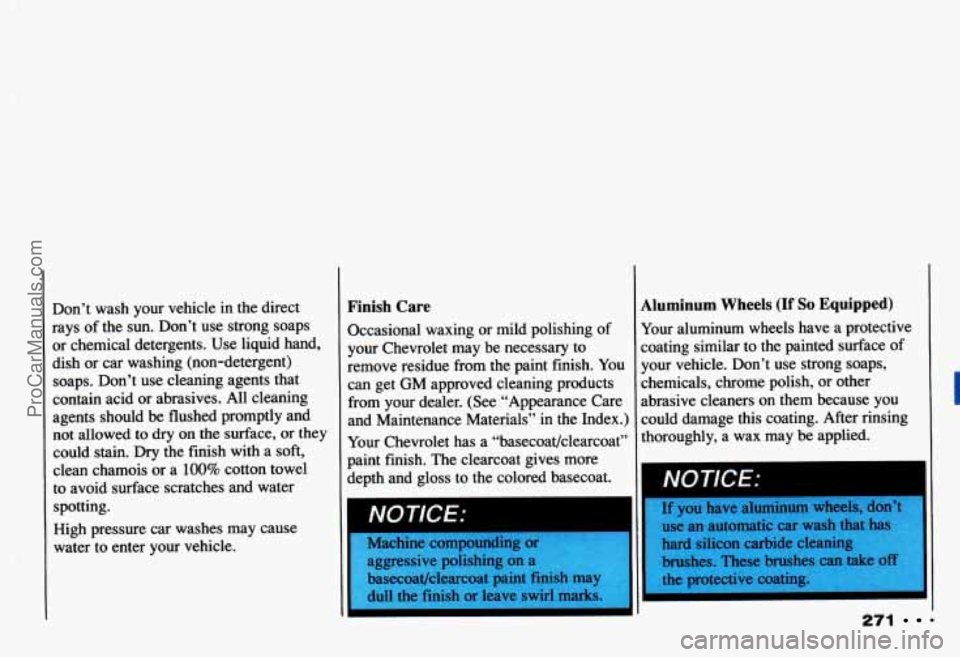
Don’t wash your vehicle in the direct
rays of the sun. Don’t use strong soaps
or chemical detergents. Use liquid hand,
dish or car washing (non-detergent) soaps. Don’t use cleaning agents that
contain acid or abrasives. All cleaning
agents should
be flushed promptly and
not allowed
to dry on the surface, or they
could stain.
Dry the finish with a soft,
clean chamois or a 100% cotton towel
to avoid surface scratches and water
spotting.
High pressure car washes may cause
water
to enter your vehicle.
Finish Care
Occasional waxing or mild polishing of
your Chevrolet may be necessary to
remove residue from the paint finish. You
can get
GM approved cleaning products
from your dealer. (See “Appearance Care
and Maintenance Materials” in the Index.)
Your Chevrolet has a “basecoat/clearcoat”
paint finish. The clearcoat gives more
depth and gloss to the colored basecoat.
I NOTICE:
aggressive polishing on a
basecoat/clearcoat paint finish may
dull the finish or leave swirl marks.
4luminum Wheels (If So Equippea)
Your aluminum wheels have a protective
:oating similar to the painted surface
of
your vehicle. Don’t use strong soaps,
zhemicals, chrome polish, or other
ibrasive cleaners on them because you
:ould damage this coating. After rinsing
;horoughly, a wax mav be applied.
If you have aluminum wheels, da ’&
use an automatic car wash that has
hard silicon carbide cleaning
brushes. These brushes can
tak- ~ff
the protective coating.
1
271
ProCarManuals.com
Page 293 of 358
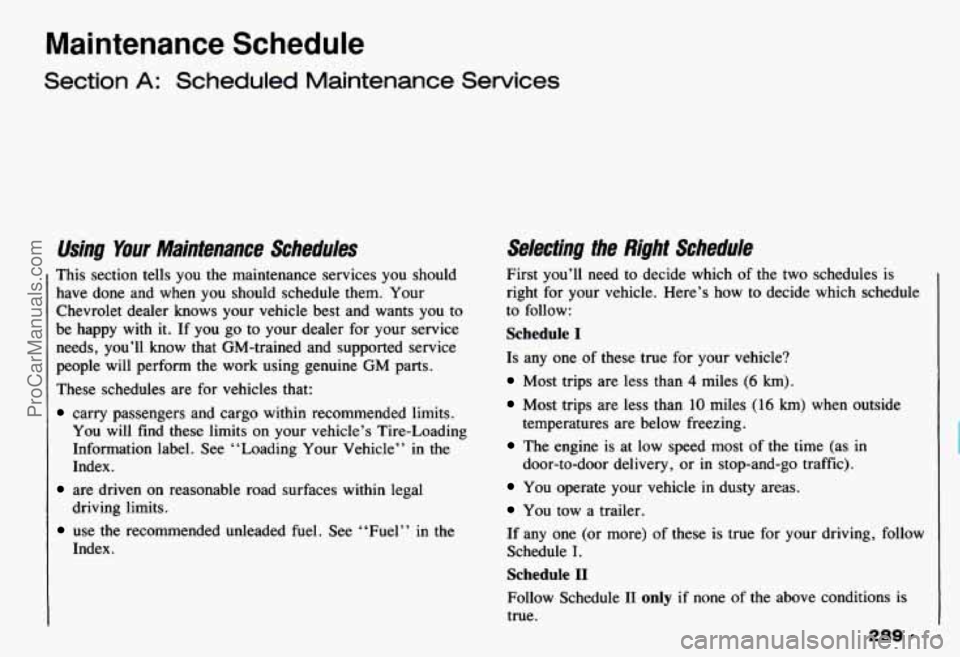
Maintenance Schedule
Section A: Scheduled Maintenance Services
Using Your Maintenance Schedules
This section tells you the maintenance services you should have done and when you should schedule them. Your
Chevrolet dealer knows your vehicle best and wants you to
be happy
with it. If you go to your dealer for your service
needs, you’ll know that GM-trained and supported service people will perform the work using genuine
GM parts.
These schedules are for vehicles that:
carry passengers and cargo within recommended limits.
You will find these limits on your vehicle’s Tire-Loading
Information label. See “Loading Your Vehicle” in the
Index.
are driven on reasonable road surfaces within legal
use the recommended unleaded fuel. See “Fuel” in the
driving limits.
Index.
Se/ecting the Right Schedule
First you’ll need to decide which of the two schedules is
right for your vehicle. Here’s how to decide which schedule
to follow:
Schedule I
Is any one of these true for your vehicle?
Most trips are less than 4 miles (6 km).
Most trips are less than 10 miles (16 km) when outside
temperatures are below freezing.
The engine is at low speed most of the time (as in
door-to-door delivery, or
in stop-and-go traffic).
You operate your vehicle in dusty areas.
You tow a trailer.
If any one (or more) of these is true for your driving, follow
Schedule I.
Schedule I1
Follow Schedule II only if none of the above conditions is
true.
289 9 .
ProCarManuals.com
Page 294 of 358

Maintenance Schedule
Section A: Scheduled Maintenance Services (Cont.)
Schedule I
Follow Schedule I if your vehicle is
MAINLY driven under one or more of
the following conditions:
When most trips are less than 4 miles
When most trips are less than 10 miles
(6 km).
(16 km) and outside temperatures
remain below freezing.
When most trips include extended
idling and/or frequent low-speed
operation, as in stop-and-go traffic.
When towing a trailer.
When operating in dusty areas.
Schedule I should also be followed if
the vehicle is used for delivery service, police, taxi or other commercial
applications.
*An Emission Control Service.
ft The U. S. Environmental Protection Agency
has determined that the failure to perform
this maintenance item will not nullify the
emission warranty or limit recall liability
prior to the completion
of vehicle usehl
life. General Motors, however, urges that
all recommended maintenance services be
performed at the indicated intervals and
the maintenance be recorded in “Section
E:
Maintenance Record. ”
9 290
ITEM
NO.
2
4
6
8
10 -
WHAT TO SERVICE
See “Explanation of Scheduled Maintenance
Services” following Schedules
I and II.
WHEN TO PERFORM
Miles (kilometers) or Months
(whichever occurs first).
Chassis Lubrication I Every other oil change. ~~
I
Transmission Service I
See “Explanation of Scheduled Maintenance
Services” following Schedules
I and II. I
Spark Plugwire Inspection** 1
Every 30,000 Miles (50 OOO km).
Fuel Tank, Cap & Lines Inspection** I
ProCarManuals.com
Page 300 of 358
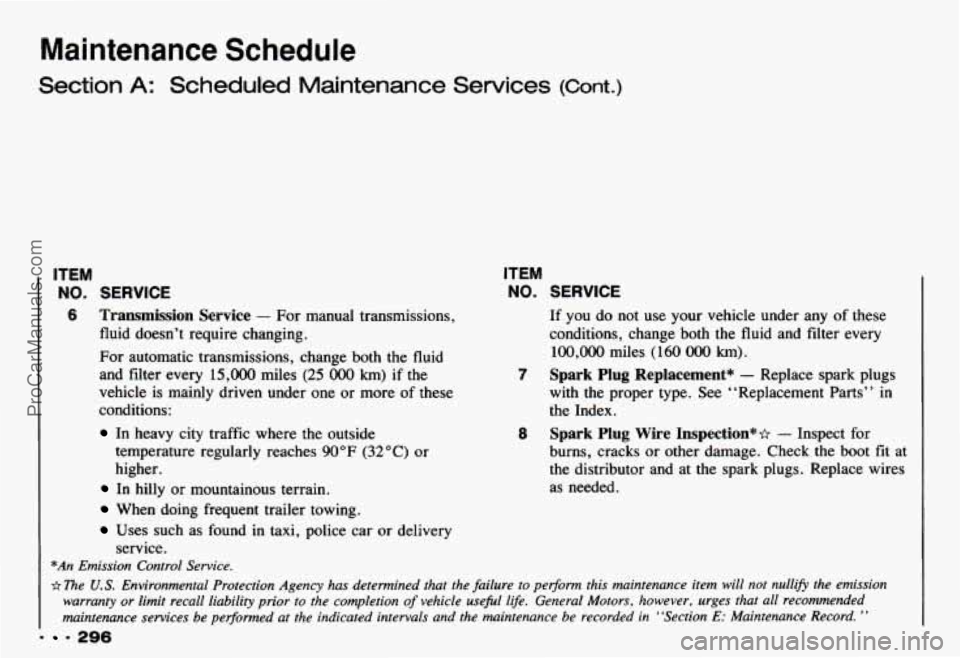
Maintenance Schedule
aection A: Scheduled Maintenance Services (Cont.)
ITEM
NO. SERVICE
6 Transmission Service - For manual transmissions,
fluid doesn’t require changing.
For automatic transmissions, change both the fluid
and filter every
15,000 miles (25 OOO km) if the
vehicle is mainly driven under one
or more of these
conditions:
ITEM
NO. SERVICE
If you do not use your vehicle under any of these
conditions, change both the fluid and filter every
100,OOO miles (160 O00 km).
7 Spark Plug Replacement* - Replace spark plugs
with the proper type. See “Replacement Parts” in
the Index.
burns, cracks or other damage. Check
the boot fit at
the distributor and at
the spark plugs. Replace wires
as needed.
8 Spark Plug Wire Inspection** - Inspect for In heavy city traffic where the outside
temperature regularly reaches
90°F (32°C) or
higher.
In hilly or mountainous terrain.
When doing frequent trailer towing.
Uses such as found in taxi, police car or delivery
service.
*An Emission Control Service.
The
U. 5’. Environmental Protection Agency has determined that the failure to perform this maintenance item will not nullify the emission
warranty or limit recall liability prior to the completion
of vehicle useful life. General Motors, however, urges that all recommended
maintenance services be performed at the indicated intervals and the maintenance be recorded in “Section
E: Maintenance Record. ”
= 296
ProCarManuals.com
Page 323 of 358
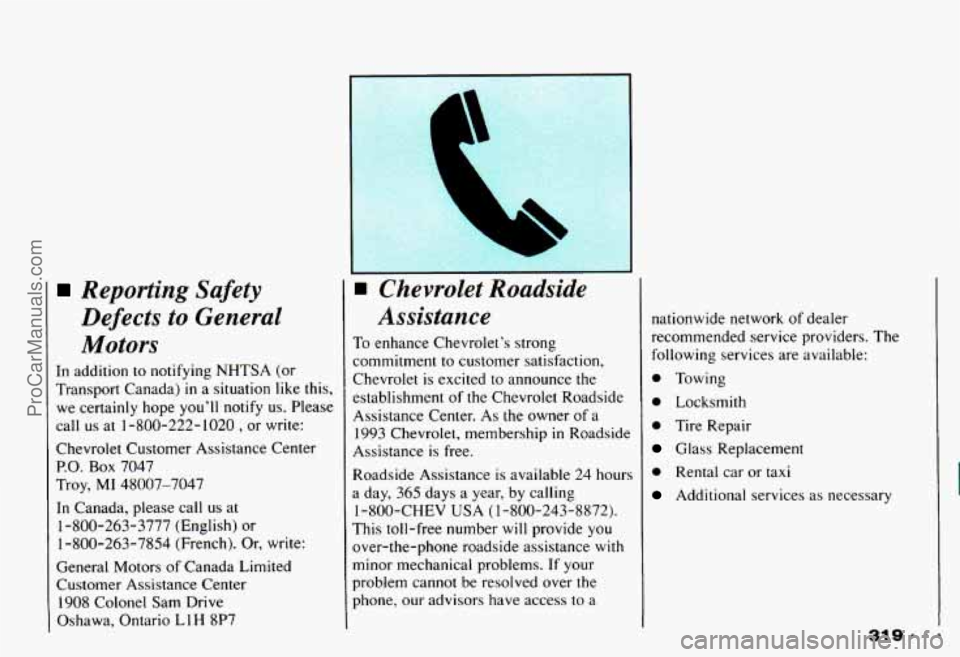
Reporting Safety
Defects to General
Motors
In addition to notifying NHTSA (or
Transport Canada)
in a situation like this,
we certainly hope you’ll notify us. Please
call us at 1-800-222- 1020
, or write:
Chevrolet Customer Assistance Center
P.O. Box 7047
Troy, MI 48007-7047
In Canada, please call us at
1-800-263-3777 (English) or
1-800-263-7854 (French). Or, write:
General Motors of Canada Limited
Customer Assistance Center
1908 Colonel Sam Drive
Oshawa, Ontario LlH
8P7
\‘r
Chevrolet Roadside
Assistance
To enhance Chevrolet’s strong
commitment to customer satisfaction,
Chevrolet is excited to announce the
establishment of the Chevrolet Roadside
Assistance Center. As the owner of
a
1993 Chevrolet, membership in Roadside
Assistance is free.
Roadside Assistance
is available 24 hours
a day,
365 days a year, by calling
1 -800-CHEV USA (1 -800-243-8872).
This toll-free number
will provide you
over-the-phone roadside assistance
with
minor mechanical problems. If your
problem cannot be resolved over the
phone, our advisors have access to
a
nationwide network of dealer
recommended service providers. The
following services are available:
0 Towing
0 Locksmith
0 Tire Repair
Glass Replacement
0 Rental car or taxi
Additional services as necessary
ProCarManuals.com
Page 338 of 358
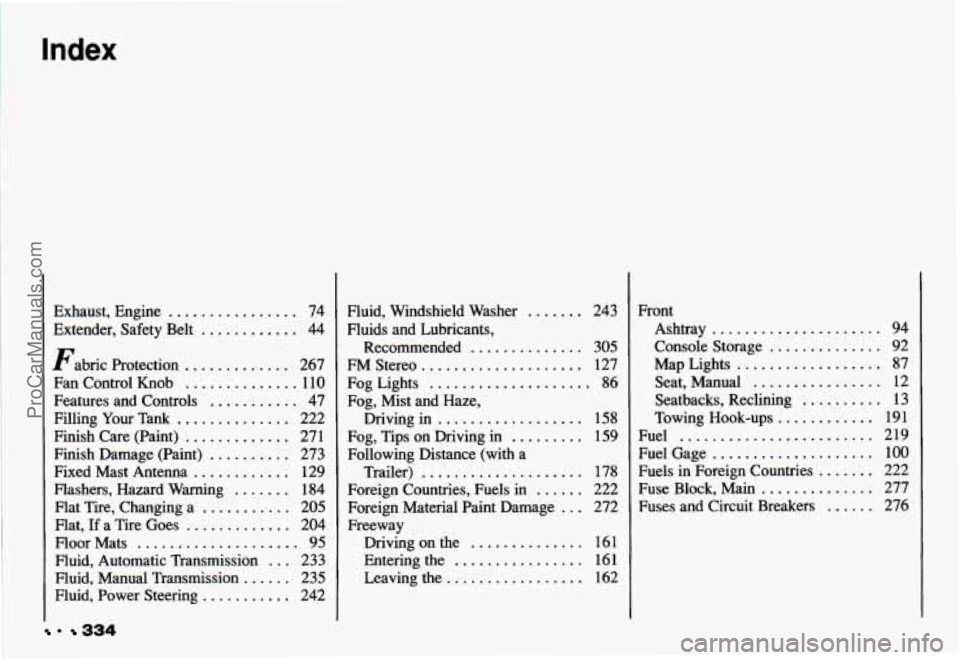
Index
Exhaust. Engine ................ 74
Extender. Safety Belt ............ 44
Fabric Protection ............. 267
Fan Control Knob .............. 110
Features and Controls ........... 47
Filling Your Tank .............. 222
Finish Care (Paint) ............. 271
Finish Damage (Paint) .......... 273
Fixed Mast Antenna ............ 129
Flashers. Hazard Warning ....... 184
Flat Tire. Changing a ........... 205
Flat. If a Tire Goes ............. 204
Floor Mats .................... 95
Fluid. Automatic Transmission ... 233
Fluid. Manual Transmission ...... 235
Fluid. Power Steering ........... 242
. 334
Fluid. Windshield Washer ....... 243
Fluids and Lubricants.
Recommended
.............. 305
FM Stereo .................... 127
Fog Lights .................... 86
Fog. Mist and Haze.
Driving in
.................. 158
Fog. Tips on Driving in ......... 159
Following Distance (with a
Trailer)
.................... 178
Foreign Countries. Fuels in ...... 222
Freeway Foreign Material Paint Damage
... 272
Driving on the .............. 161
Entering the ................ 16 1
Leaving the ................. 162
Front Ashtray
..................... 94
Map Lights .................. 87
Seat. Manual ................ 12
Console Storage .............. 92
Seatbacks. Reclining .......... 13
Towing Hook-ups ............ 191
Fuels in Foreign Countries ....... 222
Fuel ........................ 219
Fuel Gage .................... 100
Fuse Block. Main .............. 277
Fuses and Circuit Breakers ...... 276
ProCarManuals.com